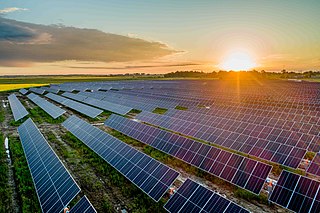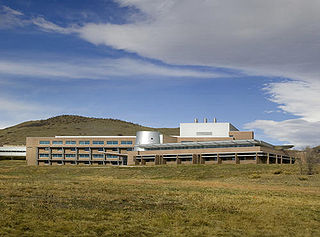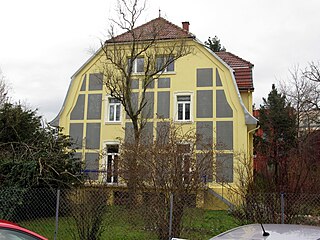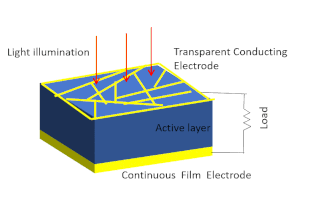Related Research Articles

Solar energy is radiant light and heat from the Sun that is harnessed using a range of technologies such as solar power to generate electricity, solar thermal energy, and solar architecture.

The National Renewable Energy Laboratory (NREL) in the US specializes in the research and development of renewable energy, energy efficiency, energy systems integration, and sustainable transportation. NREL is a federally funded research and development center sponsored by the Department of Energy and operated by the Alliance for Sustainable Energy, a joint venture between MRIGlobal and Battelle. Located in Golden, Colorado, NREL is home to the National Center for Photovoltaics, the National Bioenergy Center, and the National Wind Technology Center.

Passive house is a voluntary standard for energy efficiency in a building, which reduces the building's ecological footprint. It results in ultra-low energy buildings that require little energy for space heating or cooling. A similar standard, MINERGIE-P, is used in Switzerland. The standard is not confined to residential properties; several office buildings, schools, kindergartens and a supermarket have also been constructed to the standard. Passive design is not an attachment or supplement to architectural design, but a design process that integrates with architectural design. Although it is principally applied to new buildings, it has also been used for refurbishments.
In the 19th century, it was observed that the sunlight striking certain materials generates detectable electric current - the photoelectric effect. This discovery laid the foundation for solar cells. Solar cells have gone on to be used in many applications. They have historically been used in situations where electrical power from the grid was unavailable.

Armand Paul Alivisatos is an American chemist who serves as the 14th president of the University of Chicago. He is a pioneer in nanomaterials development and an authority on the fabrication of nanocrystals and their use in biomedical and renewable energy applications. He was ranked fifth among the world's top 100 chemists for the period 2000–2010 in the list released by Thomson Reuters.

A Zero Energy Building (ZEB), also known as a Net Zero Energy (NZE) building, or a Zero Net Energy (ZNE) building, is a building with net zero energy consumption, meaning the total amount of energy used by the building on an annual basis is equal to the amount of renewable energy created on the site or in other definitions by renewable energy sources offsite, using technology such as heat pumps, high efficiency windows and insulation, and solar panels. The goal is that these buildings contribute less overall greenhouse gas to the atmosphere during operations than similar non-ZNE buildings. They do at times consume non-renewable energy and produce greenhouse gases, but at other times reduce energy consumption and greenhouse gas production elsewhere by the same amount. Zero-energy buildings are not only driven by a want to have less of an impact on the environment, but they are also driven by money. Tax breaks as well as savings on energy costs make Zero-energy buildings financially viable. A similar concept approved and implemented by the European Union and other agreeing countries is nearly Zero Energy Building (nZEB), with the goal of having all new buildings in the region under nZEB standards by 2020.

The International Solar Energy Society (ISES) is a non-profit UN-accredited membership NGO dedicated to the advancement of the utilization of solar energy and the transformation towards 100% renewable energy.
The American Solar Energy Society (ASES) is an association of solar professionals and advocates in the United States. Founded in 1954, ASES is dedicated to inspiring an era of energy innovation and speeding the transition toward a sustainable energy economy. The nonprofit advances education, research and policy.

The use of solar energy began in Israel in the 1950s with the development by Levi Yissar of a solar water heater to address the energy shortages that plagued the new country. By 1967 around 5% of water of households were solar heated and 50,000 solar heaters had been sold. With the 1970s oil crisis, Harry Zvi Tabor developed the prototype of the solar water heater now used in over 90% of Israeli homes. There are over 1.3 million solar water heaters installed as a result of mandatory solar water heating regulations.
Narec, since 2014 known as the National Renewable Energy Centre, is a part of the Offshore Renewable Energy (ORE) Catapult, a British technology innovation and research centre for offshore wind power, wave energy, tidal energy and low carbon technologies. ORE Catapult's head office is in Glasgow, Scotland. The centre operates multi-purpose offshore renewable energy test and demonstration facilities. It is similar to other centres, such as NREL in the US and National Centre for Renewable Energies (CENER) in Spain. The National Renewable Energy Centre is based in Blyth, Northumberland.
Arthur J. Nozik is a researcher at the National Renewable Energy Lab (NREL). He is also a professor at the University of Colorado, which is located in Boulder. He researches semiconductor quantum dots at the National Renewable Energy Laboratory, and is a chemistry professor at the University of Colorado. He also does research for the advancement of solar energy, for which he won the Intergovernmental Renewable Energy Organization (IREO) Award for Science and Technology in 2009.
George Oscar Löf was an American engineer and inventor who was best known for his contributions to solar energy research. "Nobody played a more enduring role in the 20th century solar house movement than George Löf."
Richard Steven "Dick" Levine is an American environmental architect, solar energy and sustainability pioneer, and professor at the University of Kentucky. He is one of the early solar energy innovators in the U.S., a holder of U.S. patents on structural systems and solar energy applications, and the architect of a number of award winning solar buildings including his widely published Raven Run Solar House (1974). Levine is co-director of the Center for Sustainable Cities at the University of Kentucky. His contributions to sustainable urban planning are in both the theory and practice of the sustainable city-region. He has over 150 publications on solar energy and sustainability research, conducted in Italy, Austria, China and the Middle East.

Solar cell efficiency refers to the portion of energy in the form of sunlight that can be converted via photovoltaics into electricity by the solar cell.
National Solar Conference and World Renewable Energy Forum 2012 is an academic/scientific conference combined with a solar industry trade exhibition, to be held at the Denver Convention Center in Colorado, May 13 to 19, 2012.
Kenneth L. Haggard is an American architect, educator, and solar pioneer who has designed more than 300 buildings and seen more than 200 built. He is a licensed architect in California and Florida. He and his partner Polly Cooper were awarded the American Solar Energy Society Passive Solar Pioneer Award in 1996. They have been leaders in both passive solar architecture and the rediscovery of straw bale building.

Ralph Lewis Knowles is an American professor emeritus of architecture and a leading theorist of solar access design. He created the concept of the "solar envelope" and championed solar access planning. The solar envelope has influenced many city design and planning documents. He is a fellow of the American Solar Energy Society and an ACSA Distinguished Professor. He received the prestigious AIA Medal for research in 1974.
Frank Kreith was an American mechanical engineer.
Jane H. Davidson is an American mechanical engineer whose research involves renewable energy, thermal energy storage, alternative fuel, and solar-powered carbon capture and storage for the energy needs of homes, workplaces, and vehicles. She is a professor of mechanical engineering at the University of Minnesota, where she directs the Solar Energy Laboratory, and is the former Ronald L. and Janet A. Christenson chair of renewable energy at the university.
References
- ↑ Press release "ASES Selects Raleigh for National Solar Conference in 2011" BOULDER, CO - 8/19/2009
- ↑ Colorado Renewable Energy Society